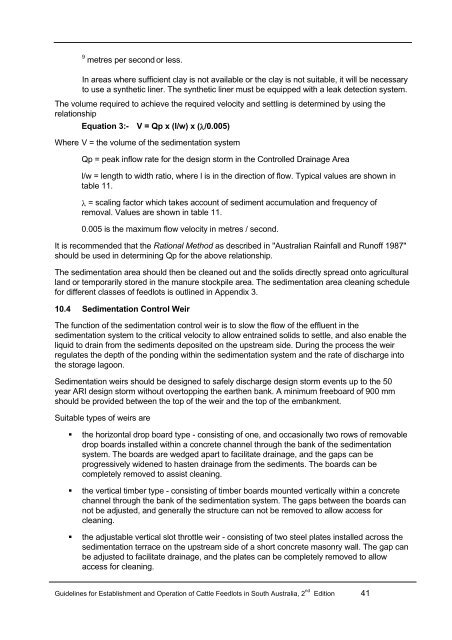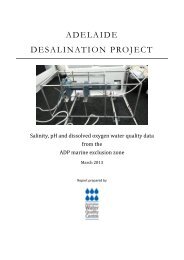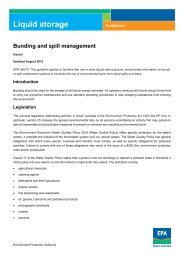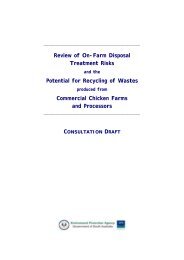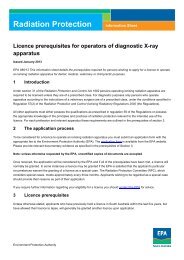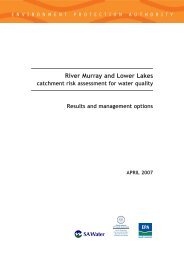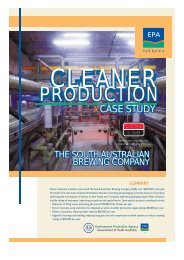Guidelines for Establishment and Operation of Cattle Feedlots in ...
Guidelines for Establishment and Operation of Cattle Feedlots in ...
Guidelines for Establishment and Operation of Cattle Feedlots in ...
Create successful ePaper yourself
Turn your PDF publications into a flip-book with our unique Google optimized e-Paper software.
9 metres per second or less.<br />
In areas where sufficient clay is not available or the clay is not suitable, it will be necessary<br />
to use a synthetic l<strong>in</strong>er. The synthetic l<strong>in</strong>er must be equipped with a leak detection system.<br />
The volume required to achieve the required velocity <strong>and</strong> settl<strong>in</strong>g is determ<strong>in</strong>ed by us<strong>in</strong>g the<br />
relationship<br />
Equation 3:- V = Qp x (l/w) x (λ/0.005)<br />
Where V = the volume <strong>of</strong> the sedimentation system<br />
Qp = peak <strong>in</strong>flow rate <strong>for</strong> the design storm <strong>in</strong> the Controlled Dra<strong>in</strong>age Area<br />
l/w = length to width ratio, where l is <strong>in</strong> the direction <strong>of</strong> flow. Typical values are shown <strong>in</strong><br />
table 11.<br />
λ = scal<strong>in</strong>g factor which takes account <strong>of</strong> sediment accumulation <strong>and</strong> frequency <strong>of</strong><br />
removal. Values are shown <strong>in</strong> table 11.<br />
0.005 is the maximum flow velocity <strong>in</strong> metres / second.<br />
It is recommended that the Rational Method as described <strong>in</strong> "Australian Ra<strong>in</strong>fall <strong>and</strong> Run<strong>of</strong>f 1987"<br />
should be used <strong>in</strong> determ<strong>in</strong><strong>in</strong>g Qp <strong>for</strong> the above relationship.<br />
The sedimentation area should then be cleaned out <strong>and</strong> the solids directly spread onto agricultural<br />
l<strong>and</strong> or temporarily stored <strong>in</strong> the manure stockpile area. The sedimentation area clean<strong>in</strong>g schedule<br />
<strong>for</strong> different classes <strong>of</strong> feedlots is outl<strong>in</strong>ed <strong>in</strong> Appendix 3.<br />
10.4 Sedimentation Control Weir<br />
The function <strong>of</strong> the sedimentation control weir is to slow the flow <strong>of</strong> the effluent <strong>in</strong> the<br />
sedimentation system to the critical velocity to allow entra<strong>in</strong>ed solids to settle, <strong>and</strong> also enable the<br />
liquid to dra<strong>in</strong> from the sediments deposited on the upstream side. Dur<strong>in</strong>g the process the weir<br />
regulates the depth <strong>of</strong> the pond<strong>in</strong>g with<strong>in</strong> the sedimentation system <strong>and</strong> the rate <strong>of</strong> discharge <strong>in</strong>to<br />
the storage lagoon.<br />
Sedimentation weirs should be designed to safely discharge design storm events up to the 50<br />
year ARI design storm without overtopp<strong>in</strong>g the earthen bank. A m<strong>in</strong>imum freeboard <strong>of</strong> 900 mm<br />
should be provided between the top <strong>of</strong> the weir <strong>and</strong> the top <strong>of</strong> the embankment.<br />
Suitable types <strong>of</strong> weirs are<br />
the horizontal drop board type - consist<strong>in</strong>g <strong>of</strong> one, <strong>and</strong> occasionally two rows <strong>of</strong> removable<br />
drop boards <strong>in</strong>stalled with<strong>in</strong> a concrete channel through the bank <strong>of</strong> the sedimentation<br />
system. The boards are wedged apart to facilitate dra<strong>in</strong>age, <strong>and</strong> the gaps can be<br />
progressively widened to hasten dra<strong>in</strong>age from the sediments. The boards can be<br />
completely removed to assist clean<strong>in</strong>g.<br />
the vertical timber type - consist<strong>in</strong>g <strong>of</strong> timber boards mounted vertically with<strong>in</strong> a concrete<br />
channel through the bank <strong>of</strong> the sedimentation system. The gaps between the boards can<br />
not be adjusted, <strong>and</strong> generally the structure can not be removed to allow access <strong>for</strong><br />
clean<strong>in</strong>g.<br />
the adjustable vertical slot throttle weir - consist<strong>in</strong>g <strong>of</strong> two steel plates <strong>in</strong>stalled across the<br />
sedimentation terrace on the upstream side <strong>of</strong> a short concrete masonry wall. The gap can<br />
be adjusted to facilitate dra<strong>in</strong>age, <strong>and</strong> the plates can be completely removed to allow<br />
access <strong>for</strong> clean<strong>in</strong>g.<br />
<strong>Guidel<strong>in</strong>es</strong> <strong>for</strong> <strong>Establishment</strong> <strong>and</strong> <strong>Operation</strong> <strong>of</strong> <strong>Cattle</strong> <strong>Feedlots</strong> <strong>in</strong> South Australia, 2 nd Edition 41


